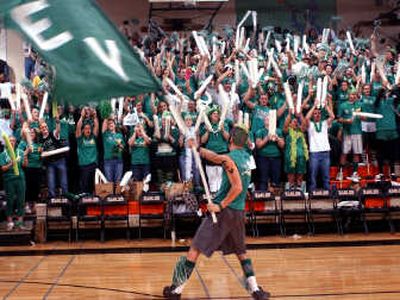Rivalries have evolved, but remain special

It was my second week as a sportswriter when I learned a valuable lesson about high school rivalries: Treat them with kid gloves.
We had decided to do a picture essay at the Spokane Valley Herald about what goes on inside the locker room of a football game before, at halftime and following.
West Valley was leading the old Border League entering the season’s final game and seemed a logical choice.
But in a bit of unfortunate timing, the full-page vignette appeared in the same issue that included the story of East Valley’s victory over the Eagles. It was the first time the two teams had met and was a huge victory for a small school just moved from the Northeast A League.
The resulting furor included outrage at what was perceived to be a Knights slight. Subscriptions were canceled.
A rivalry was born.
Today’s article by Dave Trimmer on the Idaho rivals Coeur d’Alene and Lake City brought rushing back the memory of my introduction.
Rivalries are a product of geography, dichotomy and sport itself.
Because they were Spokane’s original two public high schools, North Central versus South Central (Lewis and Clark) was a natural. Likewise, in the Spokane Valley, where Central Valley and West Valley became long-standing rivals as the small community’s two major schools.
But rivalries change. University, Ferris and Mt. Spokane are Adam’s ribs taken from CV, LC and Mead, respectively. For the very reason of that symbiosis, new rivalries emerged.
The fact that schools excel in a specific sport can create intense rivalries. Talk with unofficial City League historian Ken Eilmes and he remembers the years from the 1940s to mid-1960s when Gonzaga Prep and Rogers football teams fought fiercely and usually compiled the best combined records of each decade.
“Without a doubt, Rogers and Gonzaga,” said Eilmes, when asked if the two North Side schools had a rivalry. “It was a big rivalry. I can remember just the thrill of going to the game.”
All the way back to elementary school summer park ballgames, he said. As a kid, before he played at Rogers (and later coached baseball at NC), Eilmes recalled the time he and friends ran beneath the cars of a slow-moving train so they wouldn’t miss the start of a Pirates-Bullpups football game.
“I look back on it and think, what an idiot,” he said, “but it was barely moving.”
Rogers and Mead wrestling, because of Ken Pelo and Cash Stone, is the classic example of sport dictating a rivalry. Their matches were intense and packed the joint.
Rivalries give an ordinary game added importance, lending to upsets and bringing out the best in competition and sometimes the worst in demeanor. Back in the day there was the ritual statement making upon the fields and walls of rival schools and postgame fights were de rigueur.
Rivalries have morphed into today’s spirit games that stress civility, noise and fan involvement. Occasionally, a game breaks out.
But make no doubt about it. There’s something special about a high school rivalry.